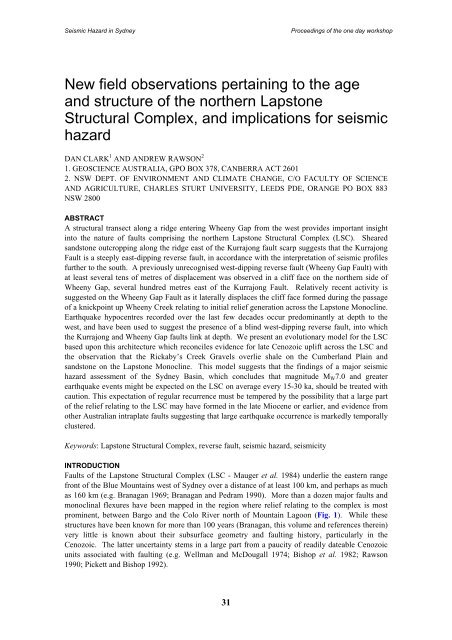Landslides in the Sydney Basin - Geoscience Australia
Landslides in the Sydney Basin - Geoscience Australia
Landslides in the Sydney Basin - Geoscience Australia
- No tags were found...
You also want an ePaper? Increase the reach of your titles
YUMPU automatically turns print PDFs into web optimized ePapers that Google loves.
Seismic Hazard <strong>in</strong> <strong>Sydney</strong>Proceed<strong>in</strong>gs of <strong>the</strong> one day workshopNew field observations perta<strong>in</strong><strong>in</strong>g to <strong>the</strong> ageand structure of <strong>the</strong> nor<strong>the</strong>rn LapstoneStructural Complex, and implications for seismichazardDAN CLARK 1 AND ANDREW RAWSON 21. GEOSCIENCE AUSTRALIA, GPO BOX 378, CANBERRA ACT 26012. NSW DEPT. OF ENVIRONMENT AND CLIMATE CHANGE, C/O FACULTY OF SCIENCEAND AGRICULTURE, CHARLES STURT UNIVERSITY, LEEDS PDE, ORANGE PO BOX 883NSW 2800ABSTRACTA structural transect along a ridge enter<strong>in</strong>g Wheeny Gap from <strong>the</strong> west provides important <strong>in</strong>sight<strong>in</strong>to <strong>the</strong> nature of faults compris<strong>in</strong>g <strong>the</strong> nor<strong>the</strong>rn Lapstone Structural Complex (LSC). Shearedsandstone outcropp<strong>in</strong>g along <strong>the</strong> ridge east of <strong>the</strong> Kurrajong fault scarp suggests that <strong>the</strong> KurrajongFault is a steeply east-dipp<strong>in</strong>g reverse fault, <strong>in</strong> accordance with <strong>the</strong> <strong>in</strong>terpretation of seismic profilesfur<strong>the</strong>r to <strong>the</strong> south. A previously unrecognised west-dipp<strong>in</strong>g reverse fault (Wheeny Gap Fault) withat least several tens of metres of displacement was observed <strong>in</strong> a cliff face on <strong>the</strong> nor<strong>the</strong>rn side ofWheeny Gap, several hundred metres east of <strong>the</strong> Kurrajong Fault. Relatively recent activity issuggested on <strong>the</strong> Wheeny Gap Fault as it laterally displaces <strong>the</strong> cliff face formed dur<strong>in</strong>g <strong>the</strong> passageof a knickpo<strong>in</strong>t up Wheeny Creek relat<strong>in</strong>g to <strong>in</strong>itial relief generation across <strong>the</strong> Lapstone Monocl<strong>in</strong>e.Earthquake hypocentres recorded over <strong>the</strong> last few decades occur predom<strong>in</strong>antly at depth to <strong>the</strong>west, and have been used to suggest <strong>the</strong> presence of a bl<strong>in</strong>d west-dipp<strong>in</strong>g reverse fault, <strong>in</strong>to which<strong>the</strong> Kurrajong and Wheeny Gap faults l<strong>in</strong>k at depth. We present an evolutionary model for <strong>the</strong> LSCbased upon this architecture which reconciles evidence for late Cenozoic uplift across <strong>the</strong> LSC and<strong>the</strong> observation that <strong>the</strong> Rickaby’s Creek Gravels overlie shale on <strong>the</strong> Cumberland Pla<strong>in</strong> andsandstone on <strong>the</strong> Lapstone Monocl<strong>in</strong>e. This model suggests that <strong>the</strong> f<strong>in</strong>d<strong>in</strong>gs of a major seismichazard assessment of <strong>the</strong> <strong>Sydney</strong> Bas<strong>in</strong>, which concludes that magnitude M W 7.0 and greaterearthquake events might be expected on <strong>the</strong> LSC on average every 15-30 ka, should be treated withcaution. This expectation of regular recurrence must be tempered by <strong>the</strong> possibility that a large partof <strong>the</strong> relief relat<strong>in</strong>g to <strong>the</strong> LSC may have formed <strong>in</strong> <strong>the</strong> late Miocene or earlier, and evidence fromo<strong>the</strong>r <strong>Australia</strong>n <strong>in</strong>traplate faults suggest<strong>in</strong>g that large earthquake occurrence is markedly temporallyclustered.Keywords: Lapstone Structural Complex, reverse fault, seismic hazard, seismicityINTRODUCTIONFaults of <strong>the</strong> Lapstone Structural Complex (LSC - Mauger et al. 1984) underlie <strong>the</strong> eastern rangefront of <strong>the</strong> Blue Mounta<strong>in</strong>s west of <strong>Sydney</strong> over a distance of at least 100 km, and perhaps as muchas 160 km (e.g. Branagan 1969; Branagan and Pedram 1990). More than a dozen major faults andmonocl<strong>in</strong>al flexures have been mapped <strong>in</strong> <strong>the</strong> region where relief relat<strong>in</strong>g to <strong>the</strong> complex is mostprom<strong>in</strong>ent, between Bargo and <strong>the</strong> Colo River north of Mounta<strong>in</strong> Lagoon (Fig. 1). While <strong>the</strong>sestructures have been known for more than 100 years (Branagan, this volume and references <strong>the</strong>re<strong>in</strong>)very little is known about <strong>the</strong>ir subsurface geometry and fault<strong>in</strong>g history, particularly <strong>in</strong> <strong>the</strong>Cenozoic. The latter uncerta<strong>in</strong>ty stems <strong>in</strong> a large part from a paucity of readily dateable Cenozoicunits associated with fault<strong>in</strong>g (e.g. Wellman and McDougall 1974; Bishop et al. 1982; Rawson1990; Pickett and Bishop 1992).31
















